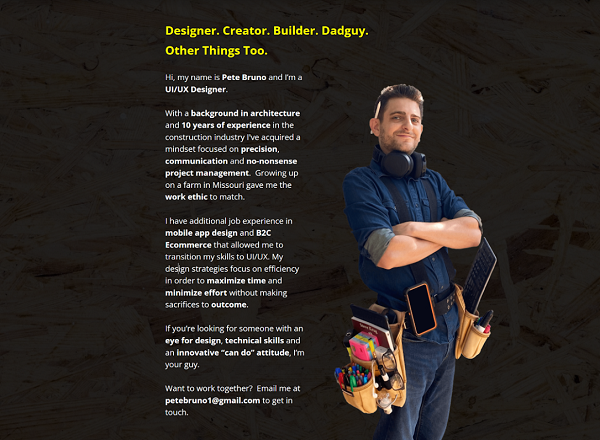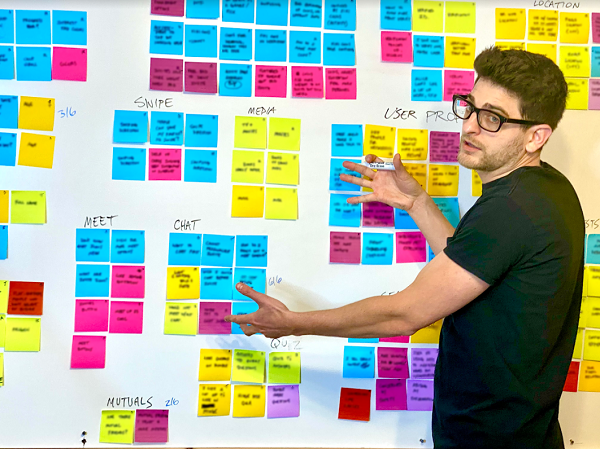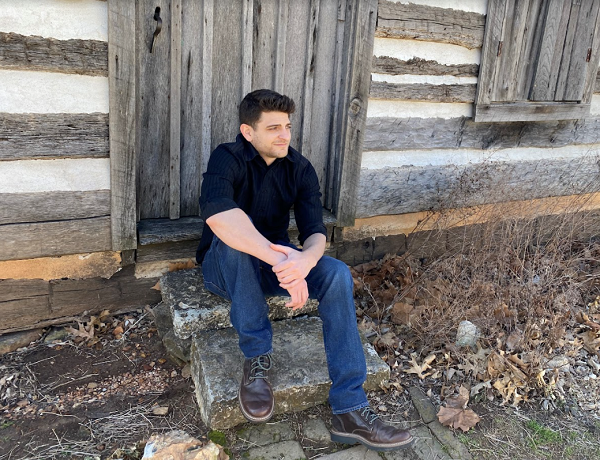
When Pete Bruno graduated with a degree in architecture on the tail end of the 2008 pandemic, the academic advisors at his university advised him and his peers to consider traveling or joining the Peace Corps in lieu of searching for a job as a new grad in the present economy. For the next few years, Pete did just that—traveling across the country and working seasonal jobs—once as a horse wrangler—so he could save enough money to go abroad. He had always wanted to put his architecture degree to use, but his skills soon became obsolete with disuse. Soon after, he had a family to support, and he wasn’t sure if he would ever find his way back into design.
Finally, Pete took a job in construction flipping houses. After one of his renovated properties sold for a handsome profit, Pete decided to pocket the money instead of feeding it back into the business. His next investment? Himself. He started searching for ways to reboot his career in design, and that’s when he discovered Springboard and the world of UX design. After growing up on a farm in Missouri and working in construction for over a decade, Pete says his strongest soft skill is his get-it-done mentality.
“I chose Springboard because it was pretty much the longest and most difficult bootcamp I could find,” said Pete, who is now a product UX designer at an agency called Service Management Group. “I’m not afraid of putting in the work and I knew that making a career transition was not something to be taken lightly.”
It was not well planned. I got a degree in architecture and graduated in 2009. It was a bad time to be looking for an entry-level job. My academic advisors in college sat us down before we received our diplomas and said, "The job market is terrible right now. Now would be a good time to travel, join the Peace Corps, or go to grad school".
I had grown up in Missouri on a farm, and I’d traveled a little bit, but I had an itch to do more. So I got a job on a pipeline through a friend, worked crazy overtime for six months, saved money so I could travel. It was awesome. I took seasonal jobs, I worked on a ranch as a horse wrangler. I loved the seasonal jobs because I could work and then travel afterward.
My architecture skills got rusty because I wasn't using them. It was just something that kept getting pushed back as something I would pursue “one day.”
After a couple of bad job experiences, I was starting to feel depressed about it and actually ended up at my last construction job, where I was flipping houses. I invested in a house that was falling apart, but had a lot of potential. After I finished it, I had some money to invest in the next one. But then I thought, this is a good opportunity for me to invest in myself and use this to do what I really want to do.
Then I saw a post on Quora from someone who worked at Springboard and that’s how I found out about UI/UX and I thought, “Wow, this is great!” It really relates to architecture in that we're designing products or experiences for people to use.
After I completed Springboard, I saw that the people around me who were getting jobs were always the perfect fit for that role. They had something going for them besides design skills. I know a guy who landed a job with a Grubhub-type food service delivery platform who had experience in the food service industry.
I thought, "This is what it takes to stand out in a sea of thousands.” So then I thought, well, I have to use what I have. Springboard also taught me there's value in transferable skills. For example, project management is a key skill in construction and there's tons of that in tech and design.
So I evaluated my background and rebranded myself in order to appeal to those types of positions, because I knew there were companies out there in construction or real estate like Home Depot or Zillow that would be looking for candidates like me. I spent two months rebuilding my portfolio to implement my new brand with a better webflow.

Yeah, that picture tells the story of my transition from construction to UI/UX. I still have my tool belt on, I'm ready to work and get things done with that same type of get-it-done attitude, but my tools have changed. That's what that picture is meant to portray. I think it's one of my strongest soft skills that I bring to the table.
My official title is Product UX Designer, and I work for an agency in Kansas City called Service Management Group that focuses on customer feedback management. They’re a SaaS company that provides a platform that enables companies to manage customer and employee feedback and use the data to provide insights.
They're a dream company for me to work for because they specialize in customer experience, employee experience and brand experience, so they truly understand the value of UX. I'm really excited to see what the future holds.
Expect the unexpected. One design challenge I did involved a website redesign. Another one was a heuristic evaluation of an e-commerce website. Sometimes you’re given a problem statement and asked how you would go about solving it.
These design challenges are a good way to evaluate the companies you're going to be working for. Sometimes you can see red flags in them. For example, the design challenge that involved a website redesign told me that the role was more focused on visual design, which is not what I was looking for. Some are obviously companies looking for free work.
The best design challenges are the ones where it’s not really about the final result. They want to see how you solve a problem, present it to the team, and incorporate feedback.

I chose Springboard because it was pretty much the longest and most difficult bootcamp I could find. I’m not afraid of putting in the work and I knew that making a career transition was not something to be taken lightly. I wasn't going to do it in two months. I knew I would need to spend a lot of time in an intensive course to really make that switch.
I also chose it because of the one-on-one mentorship, which I know is a great way for me to learn. Also, Springboard offers a career coach and career services—things I was missing when I graduated from college. Then there is the Industry Design Project, which is an internship where they turn you loose with a real company. That was a great experience too.
It was awesome. My mentor was Nick McCarthy (freelance senior product designer who has worked with clients such as Google, Facebook, and Nickelodeon). Springboard uses a quiz to match students with mentors, and we really hit it off. We were on the same wavelength and he was also just a really great teacher.
He was able to use all of his soft skills and technical UX skills to be a great teacher, a good listener, and ask questions. I looked forward to meeting him every week, getting his feedback. He was always honest and just really helped make it a positive but also educational experience for me. By the end of the course, I felt like he wasn't just a mentor to me but a friend.
I worked with a company called KiKi Social, which is a social networking app, and I had a really great experience working with them. They were really open to listening to our feedback and letting us do our thing but also being very involved at the same time and interested in what we were doing and what we had to say.

Springboard allowed me to go from a career in construction that I no longer enjoyed to feeling totally fulfilled and feeling like I finally made it. All those years of toil and money spent on college was meant for something. Now I can focus on improving other aspects of my life and I don’t have to worry about that anymore.
I think my career coach, Juliet Barrett, was a massively important factor in my success after Springboard. She gave me the tools and the mindset to land a job. She brought a really positive energy to the table. The job search is a difficult time for anyone who's going through it. To get the resources and technical skills from her but also that little boost of energy every couple of weeks was almost like being resuscitated, re-energized, and brought back to life. I would leave those meetings feeling very confident and motivated and ready to get back to it.









